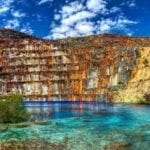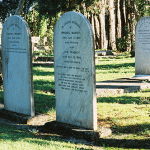 Creepy
Creepy  Creepy
Creepy  Movies and TV
Movies and TV 10 Movies That Get Elite Jobs Right, According to Experts
 Weird Stuff
Weird Stuff 10 Times Real Laws Were Based on Bizarre Hypotheticals
 Animals
Animals 10 Inspiring Tales of Horses Being Human
 Mysteries
Mysteries Top 10 Haunting Facts About the Ghost Ship MV Alta
 History
History 10 Surprising Stories About the Texas Rangers
 Humans
Humans 10 Philosophers Who Were Driven Mad by Their Own Theories
 Miscellaneous
Miscellaneous 10 Video-Game-Worthy Weapons and Armors from History
 Weird Stuff
Weird Stuff 10 Psychics Who Accurately Predicted Wartime Events
 The Arts
The Arts 10 Pieces of Art Inspired by a Broken Heart
 Creepy
Creepy 10 Death Superstitions That Will Give You the Creeps
 Movies and TV
Movies and TV 10 Movies That Get Elite Jobs Right, According to Experts
 Weird Stuff
Weird Stuff 10 Times Real Laws Were Based on Bizarre Hypotheticals
Who's Behind Listverse?

Jamie Frater
Head Editor
Jamie founded Listverse due to an insatiable desire to share fascinating, obscure, and bizarre facts. He has been a guest speaker on numerous national radio and television stations and is a five time published author.
More About Us Animals
Animals 10 Inspiring Tales of Horses Being Human
 Mysteries
Mysteries Top 10 Haunting Facts About the Ghost Ship MV Alta
 History
History 10 Surprising Stories About the Texas Rangers
 Humans
Humans 10 Philosophers Who Were Driven Mad by Their Own Theories
 Miscellaneous
Miscellaneous 10 Video-Game-Worthy Weapons and Armors from History
 Weird Stuff
Weird Stuff 10 Psychics Who Accurately Predicted Wartime Events
 The Arts
The Arts 10 Pieces of Art Inspired by a Broken Heart
10 Unsettling and Thought-Provoking Facts about Dark Tourism
We all like to get away from time to time. To visit the places we have never seen before or to return multiple times to our own favorite locations. Whether for rest, exploration, or just to immerse oneself in another culture, traveling to different places undoubtedly enriches a person’s life.
However, for some, there is a whole other type of getaway, one that might see a person on the edge of a warzone or at the scene of a recent disaster. Dark Tourism has been around for a long time and still looks set to continue well in the future.
Related: 10 Macabre Tourist Attractions
10 It’s Been Going On for Over a Hundred Years (at Least!)
While it might be tempting to think that dark tourism is a recent fad, the fact is it has been going on for over 100 years. In the book Dark Folklore, Mark and Tracey Norman document this point. They detail wealthy people taking trips in the late 1800s to such areas as Whitechapel in the East End of London, the location of the Jack the Ripper murders. This was largely to observe how the masses lived in poverty. Similar tours also took place in the Manhattan areas of New York around the same time.
As we will explore over our next few points, there are many off-branches of dark tourism that cater to an individual’s desires. The underlying detail, though, is no matter what type of destination you wish to go to and why, there will be a way to go there. And it also shows there has been a long-held desire, at least among some in the wealthy community, to visit locations of the darker kind.[1]
9 Locations Of Battles and War
Perhaps some of the first examples of war tourism can be dated to the early 1860s. During that time, many wealthy citizens would buy tickets to picnic within sight of the battlefields of the American Civil War. What is even more intriguing—several of these wealthy citizens came together to buy the land on which several of the battles took place. They planned to then sell tours of the battlefields once the war was over—which many of them did.
The previously mentioned Mark and Tracey Norman documented even earlier cases of war tourism. Many of noble standing happily paid “good prices” as far back as 1815, for example, in order to sit and dine while observing the Battle of Waterloo unfold.
Perhaps most bizarre of all—at least from a modern perspective—are the tours offered by Thomas Cook. For a price, they would offer to take people to the battlefields of the Second Boer War. Interestingly, the same company also offered what we would call “bus trips” to public hangings around the same time.[2]
8 A Discreet Tour of the Slums
There are, of course, many modern examples of what is known as slum tourism that took place in the late 1800s and early 1900. Gaining underground popularity during the 1990s and 2000s, many people would travel to poverty-hit areas in Brazil, India, and South Africa.
What is particularly ironic about the South African slum holidays is their origins lie in an official program. This program was designed to educate white Africans on how the black population lived. As the 1990s unfolded, many people from other countries around the world also wanted to take part in these tours. And while this was largely for educational purposes, an increasingly distasteful element crept in. More and more people were appearing to take such tours for no other reason than spectacle.
As the twenty-first century has gone on, many cities around the world that have notorious poorer areas have experienced this slum tourism. However, there is a particular part of dark tourism that appears to be increasing in popularity. And it is there where we will turn our attention next.[3]
7 Fascination with Scenes of Disasters
If there is one other niche location within dark tourism, it is the desire, by some, to visit areas recently hit by a disaster of one sort or another. Although they are perfectly legal, we might look at the tours of Pripyat in the decades since the Chernobyl disaster as a good example.
More recently, in the years following Hurricane Katrina in 2005, many companies offered to take tourists around the flood-hit areas. What made these particular tours even worse (the moral aspect aside) is that many claimed these tours were actually getting in the way of recovery efforts and programs.
The fact is, wherever a disaster hits—be it natural or man-made (such as the Exxon Valdez oil spill)—many will pay good money to see the devastation for themselves. And with floods, wildfires, and even volcanic eruptions happening (relatively speaking) all the time, these destinations will likely continue to increase in number.[4]
6 People Do It Without Realizing It
In many ways, it could be argued that many people take part in dark tourism without even realizing they are doing so. Perhaps the most obvious way to demonstrate this would be to highlight the many millions of people who visit Auschwitz in Poland or the Anne Frank House in Amsterdam in Holland. Both are locations that have experienced significant horror and distress. And while both are important visits from an educational experience, each could very much be described as dark tourism locations.
Perhaps another good example would be the many locations of the former Soviet Union, particularly sites with a direct connection to the Cold War, such as abandoned military facilities. Some would even argue that trips to Venice in Italy are a form of dark tourism known as doom tourism. This is primarily because it is a certainty that Venice will sink into the sea one day in the future.
These tourist trips, it could be said, have an educational purpose to them. Perhaps, then, some good comes out of dark tourism. We will return to this notion a little later on our list. Next, though, we will examine one of the most popular dark tourist sites of recent times.[5]
5 The Golan Heights Tourists
Perhaps one of the best examples of dark tourism can be found in the organized trips that venture to Golan Heights on the Israeli-Syrian border. And these tourists arrive there “armed with binoculars and cameras, eager for a glimpse of smoke and even carnage.”
One of the people who take these tourists on such grim journeys is retired Israel Defense Forces colonel Kobi Marom. He would claim in an interview with The Atlantic in 2014 that these tourists “gaze down on Syrian’s bloodletting.” He would even state that during one particularly bloody battle when rebels captured a United Nations checkpoint, many there that day were eager to see the event unfold and “gaped down at the action below…safe beyond the buffer zone.”
These tours to the brink of the battle zones are identical in nature to those of the 1860s on the sidelines of the American Civil War. And Golam Heights is far from the only example in our modern world of dark locations, as our next point examines.[6]
4 It’s Still Happening Today–In Many Ways!
As we know from some of our previous points, dark tourism is very much alive and well in the twenty-first century. What’s more, while we have examined some of the examples of dark tourism above, as the 2000s unwind, there appear to be more and more grisly locations that people are willing to spend good money to see.
Many people, for example, often travel to see locations where cults have been based. Or to buildings where serial killers might have lived while committing their crimes. Even places such as abandoned medical facilities that still have medical jars with all manner of remains inside on site.
In short, if there is a dark edge to it, you can guarantee that at least some people would wish to see it close-up. And for those who are willing to take people there, there is, and will continue to be, a lot of money to be made.[7]
3 A Future of Many Dark Locations Available
With our last point in mind, we might think that the future for such an industry will be a grim one, and well, it might be. With various tragedies and disasters unfolding around the world at any given time, there is certainly no shortage of locations to choose from. Indeed, might we see such tourist trips to Afghanistan in the near future? Or to Ukraine after the conflict ends there? The chances are, we would.
In short, locations of genocide, mass murder, areas of great conflict, and both man-made and natural disasters are many. And all are locations that some people might wish to visit. And with the world ultimately becoming increasingly smaller as technology develops, the ways in which these somber vacations can be delivered will also increase and diversify.
Before we move on to where dark tourism might go as the 2020s unfold, we will return to a point we made earlier—that there could be a good side to these morose holidays.[8]
2 A Bizarre Need For It?
Might it be that not only can some good come out of dark tourism but also that there is a need to have people visit these locations? The previously mentioned Auschwitz camp and Anne Frank House are great examples of this. After all, most would agree that the horrors of the Second World War, particularly the Holocaust, must not be forgotten. To see such locations first-hand certainly plays a part in this.
There are, though, many other locations around the world that could serve in an educational way. For example, such places that have suffered environmental disasters would only show the potential consequences of our collective actions. Visits to the Chernobyl plant and its surrounding areas could serve in a similar capacity.
If dark tourism does continue, for good or bad, there is one area where it will undoubtedly grow, and it is there we will turn our attention for our final point.[9]
1 Virtual Dark Tourism
It is perhaps no surprise that in the modern age in which we live that one could take part in dark tourism without actually leaving their living room. Virtual tourism, rightly or wrongly, is likely to increase over the years. In 2017, Facebook founder, Mark Zuckerberg, intentionally or not, made this idea a reality. He would go on a virtual tour of recently flood-hit Puerto Rico. This tour was live-streamed, leading to much criticism. This was mainly due to an apparent lack of empathy on the Facebook founder’s part.
An argument, though, could be made that such virtual tours to areas hit by tragedies could be used for good. They might be a good way to raise funds if people can see the distress for themselves, for example. And, once more, they would also perhaps serve as an educational tool.
Whether we can expect to see such virtual tours being offered anytime soon, though, remains to be seen.[10]








